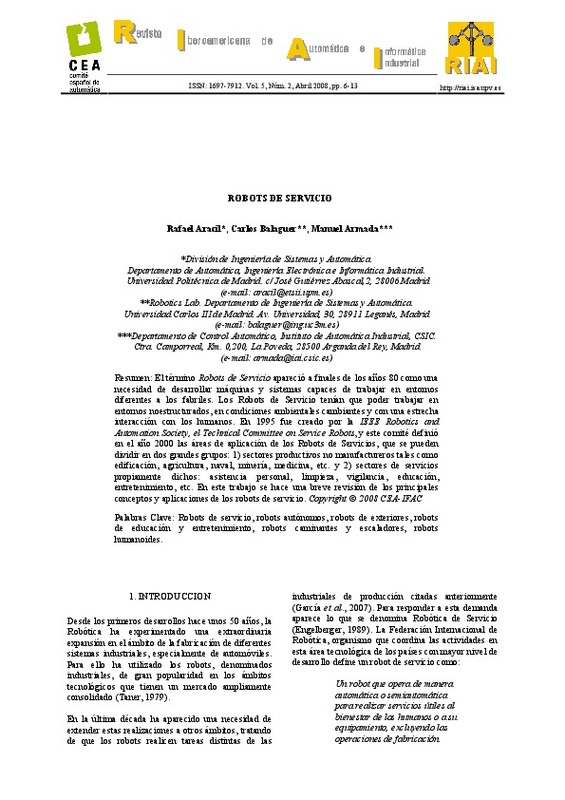JavaScript is disabled for your browser. Some features of this site may not work without it.
Buscar en RiuNet
Listar
Mi cuenta
Estadísticas
Ayuda RiuNet
Admin. UPV
Diseño de un chaleco con soporte para un brazo de asistencia a personas con discapacidad
Mostrar el registro sencillo del ítem
Ficheros en el ítem
| dc.contributor.advisor | Zotovic Stanisic, Ranko
|
es_ES |
| dc.contributor.author | Barragán Nadal, Jorge
|
es_ES |
| dc.date.accessioned | 2020-10-27T14:35:16Z | |
| dc.date.available | 2020-10-27T14:35:16Z | |
| dc.date.created | 2020-09-24 | |
| dc.date.issued | 2020-10-27 | es_ES |
| dc.identifier.uri | http://hdl.handle.net/10251/153274 | |
| dc.description.abstract | [ES] Este trabajo es la continuación de un TFM previo, realizado por el masterando José Mulet, en el que se diseñó un brazo robot portátil para asistencia a discapacitados. La función del brazo robótico es la asistencia de un paciente que no puede mover su propio brazo en la vida cotidiana. El paciente debe tener la posibilidad de ponerse y quitarse el brazo robot sin ayuda de otras personas. Cabe resaltar que se trata de un minusválido que no tiene la posibilidad de utilizar las manos. El objetivo de este TFM es el diseño de un "chaleco" que sostenga el brazo, así como del sistema para poder quitárselo. El chaleco debe ser capaz de soportar el brazo robótico, las baterías, las unidades de potencia de los motores, etc. Debe ser ergonómico. Debe ser lo más ligero y cómodo posible. A parte del chaleco, es necesario un sistema de soporte donde el paciente lo pueda dejar cuando no lo necesita. | es_ES |
| dc.description.abstract | [EN] Due to the master thesis written by José Antonio Mulet Alberola, in which he designed and built a robot arm for disabled people, the project coordinator Ranko Zotovic gave me the opportunity to design a support to carry it. The main goal was to create a kind of vet for the users in which we could integrate the power and control elements for the robot arm. In addition, the users should be able to go inside and outside of the vet without other person help. The solution should be ergonomic and as lightest as possible. Therefore, we came up with the idea of designing a system that could be adapted to the size of different people. In that way, we won´t need to redesign or adjust the size of every part if other person needs to use it. The first prototype will go to a person that suffers “Fail Arm”. It doesn´t allow him to use his arms, so he cannot perform basic tasks as take the food from the fridge or drink water. | es_ES |
| dc.format.extent | 83 | es_ES |
| dc.language | Español | es_ES |
| dc.publisher | Universitat Politècnica de València | es_ES |
| dc.rights | Reserva de todos los derechos | es_ES |
| dc.subject | Brazo robot | es_ES |
| dc.subject | Robot de asistencia | es_ES |
| dc.subject | Robot portátil | es_ES |
| dc.subject | Chaleco soporte | es_ES |
| dc.subject | Robot arm | es_ES |
| dc.subject | Robot assistance | es_ES |
| dc.subject | Support | es_ES |
| dc.subject | Support vest | es_ES |
| dc.subject.classification | INGENIERIA DE SISTEMAS Y AUTOMATICA | es_ES |
| dc.subject.other | Máster Universitario en Ingeniería Mecatrónica-Màster Universitari en Enginyeria Mecatrònica | es_ES |
| dc.title | Diseño de un chaleco con soporte para un brazo de asistencia a personas con discapacidad | es_ES |
| dc.type | Tesis de máster | es_ES |
| dc.rights.accessRights | Abierto | es_ES |
| dc.contributor.affiliation | Universitat Politècnica de València. Departamento de Ingeniería de Sistemas y Automática - Departament d'Enginyeria de Sistemes i Automàtica | es_ES |
| dc.contributor.affiliation | Universitat Politècnica de València. Escuela Técnica Superior de Ingeniería del Diseño - Escola Tècnica Superior d'Enginyeria del Disseny | es_ES |
| dc.description.bibliographicCitation | Barragán Nadal, J. (2020). Diseño de un chaleco con soporte para un brazo de asistencia a personas con discapacidad. Universitat Politècnica de València. http://hdl.handle.net/10251/153274 | es_ES |
| dc.description.accrualMethod | TFGM | es_ES |
| dc.relation.pasarela | TFGM\137401 | es_ES |
Este ítem aparece en la(s) siguiente(s) colección(ones)
-
ETSID - Trabajos académicos [8619]
Escuela Técnica Superior de Ingeniería del Diseño









